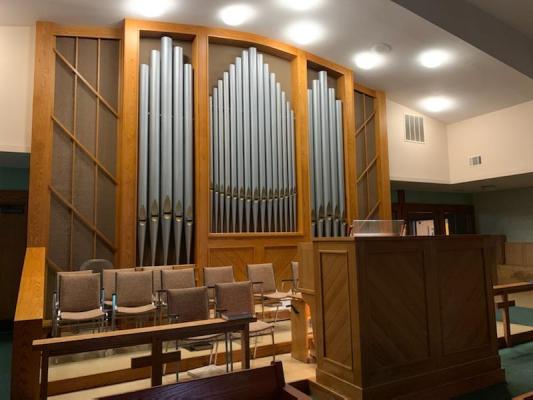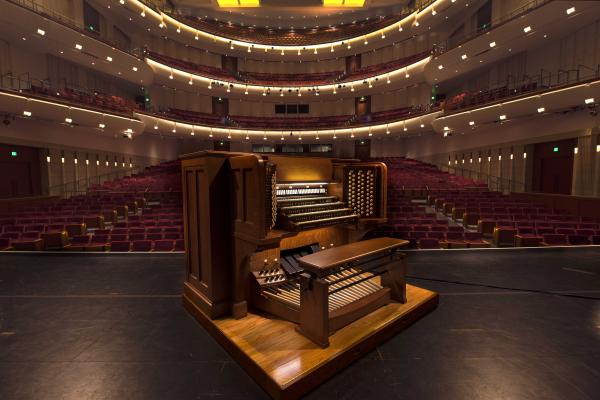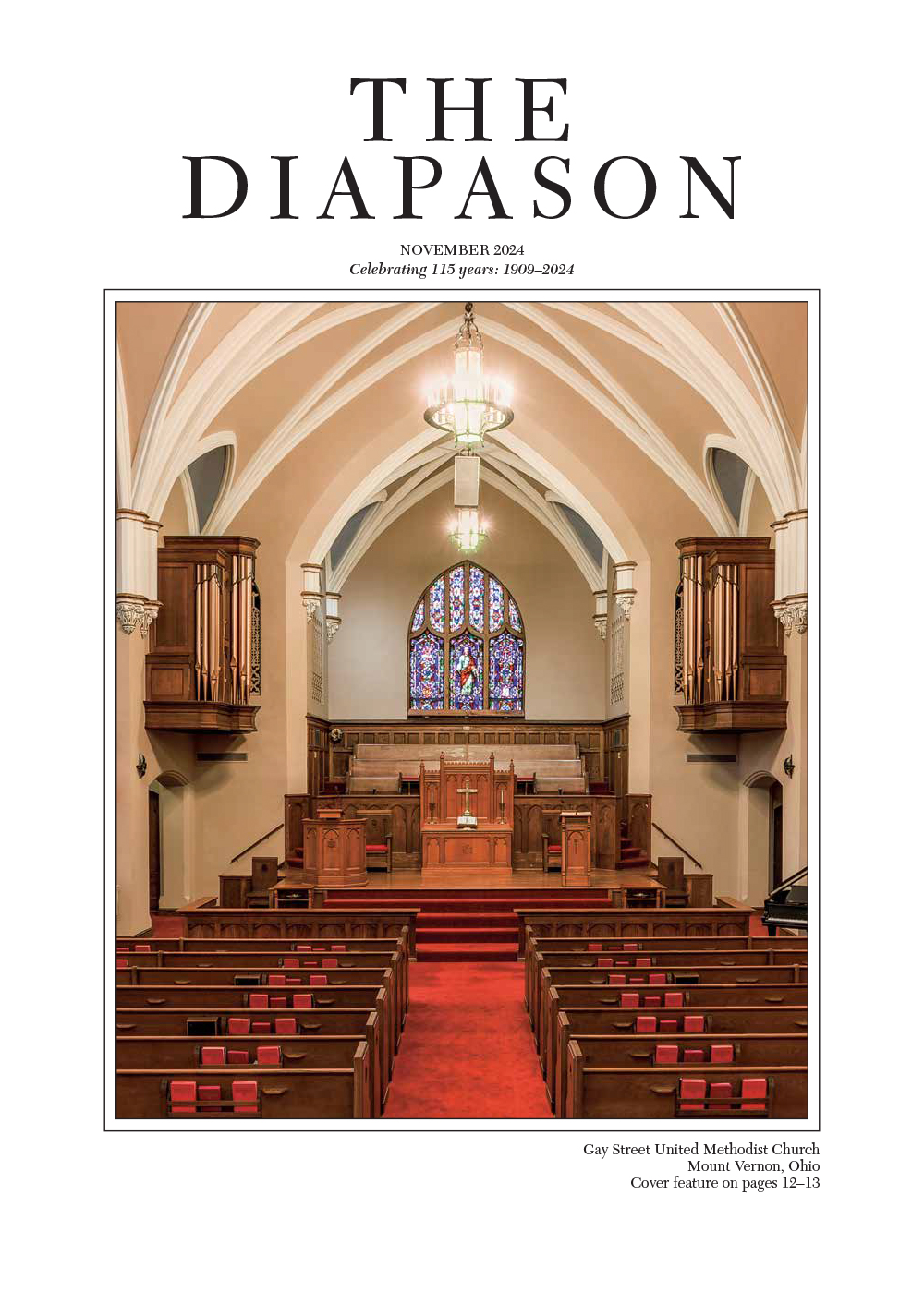Roger Banks,
Oklahoma City, Oklahoma
Reuter Organ Company,
Lawrence, Kansas
First Presbyterian Church,
Oklahoma City, Oklahoma

From Roger Banks
I first heard the M. P. Möller organ at First Presbyterian Church shortly after its installation in 1964. At that time, I was a senior at Oklahoma City University nearby. As one of the newest and largest organs in the Oklahoma City area, it should have been wonderful. After all, the specification indicated that it followed the latest trends in organbuilding and design at the time, yet I remember that, in that cavernous building, the result was much less
than satisfying.
In the intervening time between then and now, I have fully transitioned from the spare but well-intentioned organ sounds of the 1960s and 1970s, through the 1980s and 1990s, to arrive at my current tonal philosophy, which favors broader scales and divisions featuring rich fundamental tone. Thus I was delighted when John Edwards entrusted me with the care of the instrument at First Presbyterian.
The first project we undertook was to replace the failing Swell division expression pneumatics. That opened up the shade front to fully allow the sound to enter the chancel area rather than bounce off the ceiling. The improvement was immediate and quite noticeable. In 1994, the previous technician installed a new console. However, this large console appeared to have more prepared drawknobs than actual stops. I suggested that John Edwards consider not only completing the console preparations, but also replacing and/or rescaling most of the Great principal chorus as well as adding foundation stops to the other divisions. We decided to make it a two-year project to better utilize the available funding source.
It did not take long for us to realize that rescaling the existing Great 8′ Principal was hopeless. The lowest fourteen pipes were in the façade, scale 46, and nearly forced double length by the façade design. The 4′ Octave rescaled nicely, but the 2′ Weit Prinzipal as well as the IV- and III-rank mixtures were not be able to be reused. The new principal chorus that was added now has a substantial 8′ Principal and upper work to match. We also added a new Twelfth and Seventeenth to fill out the chorus. The existing Koppel Flöte was adequate, but the 8′ Nason Gedeckt and 8′ Quintadena were too similar, so I moved the Nason Gedeckt to the Quintadena chest and added a new, larger-scaled 8′ Bourdon. The 16′ Dulzian was moved to a new unit chest, and I added a new large-scale 8′ Flûte Harmonique. The Flûte Harmonique pipes were then voiced to be commanding as a solo stop in the treble, yet work well in the ensemble.
The Swell division only needed the addition of a new 8′ Diapason of adequate scale. Every other need in that division was addressed during the tonal finishing that was done later.
The Positiv division was next on the list. It was typical of the period, yet still an effective division. I moved the 8′ Geigen from the Choir to a new unit chest above the Great in order to provide some foundation at 8′ and 4′ pitches. As a result, we also discovered that it makes an impressive 16′ Double on the Great. The existing 11⁄3′ was of flute tone, so I replaced it with pipes from the old Great IV Mixture. The remaining issues again were done during the final tonal work.
The Choir division was an interesting challenge. It was originally designed as the enclosed division to partner with the Positiv. After the 1994 revision, the Choir was left on its own. It had the 8′ Geigen, a hybrid 4′ Gemshorn/Principal, a pair of Erzählers, a large 8′ Clarinet, and a 4′ Hautbois. It was not a lot to work with.
By the time we addressed the Choir, work on the other divisions had rapidly depleted funding for the project. Fortuitously, the church had several vintage ranks in storage from a donated Kimball, and I had several nice stops remaining from various earlier projects. For example, I had a lovely 8′ Reuter Spitz Principal that we installed on the now vacant 8′ Geigen chest. The church had a wonderful 8′ open wood Kimball Claribel Flute that was installed where the 8′ Krummhorn had been. I had a new chest built to hold a pretty 4′ Möller Flute d’Amour and III–IV Mixture, and Reuter built the bottom octave for the Hautbois to make it an 8′. We also added a lovely set of Kimball 8′ strings which reside in the enclosed Bombarde division that sits atop the choir. To increase versatility, there is now a knob that allows the Choir expression to operate the Bombarde expression when the strings are used on the Choir. Tonal finishing did wonders to tie together all the disparate pipework in the Choir. The division now has purpose and adds a great deal of color to the entire ensemble.
The Bombarde division also received a vintage 4′ Harmonic Flute. It adds color to the 8′ English Horn and sneaks in as a filler with the strings.
The Pedal division had the fewest needs, though we did add a larger scale 8′ Diapason to augment the existing 8′ Principal. This gave the Pedal a better 8′ line. The remaining work was done in the tonal finishing phase.
I cannot thank JR Neutel from Reuter enough for the marvelous job he did during the tonal finishing phase. I have worked with him on many instruments in the last twenty years. He has limitless energy coupled with complete mastery of dealing with pipework that appears to be hopeless. We spent over three weeks going through every pipe in the organ. The completed organ now has the weight to carry the length of the nave, but it is still nimble enough to play the lightest literature. I would also like the thank G. Mark Caldwell, Marty Larsen, Tom Birkett, and John Riester for their assistance in making the completed instrument possible.
—Roger Banks
Oklahoma City, Oklahoma
From Reuter Organ Company
This project is unique in that it was not conceived in the typical relationship that many equate with a “main-line builder” and the “sales representative.” In this case, Roger Banks called upon us to consult with him—a partnership of equals. Together we discussed numerous ideas of how to tonally enhance the organ, culminating with all of the specific details needed to complete this tonal enhancement, including final pipe scales and wind pressures to achieve the objective. Reuter was then given the opportunity to provide the new pipes and chests that Roger needed. Reuter has been fortunate to develop similar relationships with other affiliates over the past decade.
While Roger has had a fifty-plus year relationship with Reuter, he and I began working together on numerous installations, most notably back to 2001, when he first assisted me with the voicing of our flagship instrument at Saint John’s Cathedral in Albuquerque, New Mexico. I was honored when Roger asked me to take the lead on the revoicing of the organ at First Presbyterian Church. I also thank John Edwards for his confidence and support. With an instrument of this size the undertaking was daunting. Roger’s ability to “massage” new sounds out of old pipes as well as working with new pipes is second to none. With our combined abilities and weeks of on-site voicing time, the desired results were achieved.
This “new” organ at First Presbyterian, along with two other recently completed organ renovations in Oklahoma City (Christ the King Catholic Church and Oklahoma City University), and a soon to be completed project at Westminster Presbyterian Church, are the culmination of a rewarding partnership and friendship with Roger. We applaud Roger and his successful career as one of the central state’s leading organ specialists and extend our deep appreciation for his leadership on this project. The renewed organ stands as a landmark instrument in the area!
—JR Neutel
Reuter Organ Company
From John L. Edwards
Standing for over half a century on its northwest Oklahoma City site, the fourth house of worship of First Presbyterian Church is a grand Gothic structure of Tennessee limestone. In addition to its impressive stained glass windows, the building boasts four pipe organs: chapel (1956 Austin, two manuals, fifteen ranks); Watchorn Hall (1956 M. P. Möller, two manuals, four ranks); choir room (1965 Walcker, two manuals, eleven ranks); and sanctuary (1964 M. P. Möller, four manuals, seventy-one ranks; 2016 Banks-Reuter, four manuals, nintety-one ranks). The “4X4 Organ Concert” is unique and very popular to the Oklahoma City community, four organists playing four pipe organs moving from venue to venue.
From its 1889 beginnings, the church has regarded music as a primary form of worship and, to that end, has had many well-known church musicians leading that endeavor. John S. C. Kemp served as minister of music from 1949 to 1968 with encore service from 1983 to 1986. During these periods of service, his wife, Helen developed her expansive work with children as well as her soaring soprano voice. In their honor, the church now has a free concert series named for them. John Blackwell followed the Kemps’ first term of service. Organists have included Wilma Jensen and Samuel C. Hutchison. Several others served shorter terms or as music interns for a year of their undergraduate studies. Those include Elaine Warner Chard, Louise Bass, Dorothy Kosanke-Elder, Greg Funfgeld, Eric Howe, Mark Lawlor, and Glenn A. Miller, among others.
While meeting for Sunday worship in Watchorn Hall until completion of the sanctuary in 1964, an organ committee chaired by DeWitt B. Kirk and then-organist Gale Norman Enger chose the M. P. Möller Organ Co. of Hagerstown, Maryland, to build the new instrument for the 1,400-seat sanctuary. Completed in 1964, Opus 9862 had four manuals with seventy ranks in the chancel and one “En Chamade” rank at the rear of the church. Wilma Jensen oversaw
the installation.
In 1992 a decision was made to purchase a new console and solid-state operating system, with preparations for future additions. The console plus four ranks were added in 1994. Organ committee chair, Dargan Mayberry, organist John L. Edwards, and director of music Michael W. Yeager, along with consultants John Balka, Fred Haley, Jon Olin Roberts, Frederick Swann, and Laura van der Windt worked together with the McCrary Pipe Organ Service of Oklahoma City, Oklahoma, to complete this project.
By 2014 the pneumatics to the Swell expression shades had failed. It was decided to replace them with new electric motors for the operation that also allowed for expanded opening of the louvers. This improvement then led to the discussion of revoicing existing ranks and adding ranks of pipes to better facilitate the lack of fundamental tone experienced in the nave of the church. Roger A. Banks, current curator of the instruments at First Presbyterian Church, in conjunction with JR Neutel of the Reuter Organ Company, presented a plan for rescaling certain pipes, adding new pipework, and relocating several stops to alternate divisions. Additionally, some vintage pipework was available and incorporated into the instrument, notably from organs made by W. W. Kimball, Estey, M. P. Möller, Reuter, McManis, and even a Robert Morton Clarinet. The Hooded Tuba was sent to Reuter to be revoiced for a more commanding and appropriate Tuba quality. All in all, sixteen ranks were added in 2016, and the organ became an instrument of ninety-one ranks with 5,269 pipes. I was honored to present an inaugural recital on May 1, 2016, which also marked my twenty-fifth anniversary on staff at First Presbyterian Church.
Working closely with Roger Banks has been a highlight for me and for our church. He has become family to us. His knowledge and expertise are unsurpassed! Roger and JR Neutel, president of the Reuter Pipe Organ Company, went through every single pipe of the instrument, critically listening and voicing each to give the best and necessary response to the cavernous space of the sanctuary. The finished result is a warm and rich singing sound extending into the nave, especially noticed by stronger congregational singing.
—John L. Edwards, organist
First Presbyterian Church
Photo credit: Kathy Rangel, except where noted
GREAT (Manual II)
16′ Geigen (ext 8′, 1–12 electronic)
16′ Quintadena 73 pipes
16′ Claribel Flute (Ch)
8′ Principal 61 pipes
8′ Geigen 73 pipes
8′ Flûte Harmonique 61 pipes
8′ Bourdon 61 pipes
8′ Quintade (ext)
51⁄3′ Quint (TC, fr 22⁄3′)
4′ Octave 61 pipes
4′ Koppelflöte 61 pipes
31⁄5′ Grossterz (TC, fr 13⁄5′)
22⁄3′ Twelfth 61 pipes
2′ Fifteenth 61 pipes
2′ Flageolet 61 pipes
13⁄5′ Seventeenth 61 pipes
IV Fourniture 11⁄3′ 244 pipes
III Scharf 1′ 183 pipes
16′ Dulzian 73 pipes
8′ Bombarde (Ped)
8′ Dulzian (ext)
Tremolo
Great to Great 16
Great Unison Off
Great to Great 4
Chimes (G2 – G4, volume 0–5)
Carillon
SWELL (Manual III, expressive)
16′ Rohrbass 73 pipes
8′ Diapason 73 pipes
8′ Viola Pomposa 61 pipes
8′ Viola Céleste 61 pipes
8′ Rohrflöte (ext)
8′ Flûte Céleste II 110 pipes
4′ Octave Diapason (ext)
4′ Praestant 61 pipes
4′ Flûte Harmonique 61 pipes
22⁄3′ Nazard 61 pipes
2′ Flachflöte 61 pipes
13⁄5′ Tierce 61 pipes
IV Plein Jeu 11⁄3′ 244 pipes
III Cymbal 1′ 183 pipes
32′ Contra Fagotto (TC, fr 16′)
16′ Fagotto 73 pipes
8′ Trompette 61 pipes
8′ Fagotto Oboe (ext)
8′ Vox Humana 61 pipes
4′ Clairon 61 pipes
Tremolo
Swell to Swell 16
Swell Unison Off
Swell to Swell 4
CHOIR (Manual I, expressive)
16′ Erzähler 73 pipes
8′ Spitz Principal 61 pipes
8′ Salicional (Bomb)
8′ Voix Céleste (Bomb)
8′ Erzähler (ext)
8′ Erzähler Céleste (TC) 49 pipes
8′ Claribel Flute 85 pipes
4′ Gemshorn Principal 61 pipes
4′ Flauto d’Amore 61 pipes
2′ Claribel Fife (ext)
III–IV Mixture 2′ 190 pipes
8′ Clarinet 61 pipes
8′ Cromorne (Pos)
8′ Hautbois 61 pipes
Tremolo
Choir to Choir 16
Choir Unison Off
Choir to Choir 4
POSITIV (floating)
16′ Quintadena (Gt)
16′ Claribel Flute (Ch)
8′ Geigen (Gt)
8′ Holz Bordun 61 pipes
4′ Geigen (Gt)
4′ Rohrflöte 61 pipes
22⁄3′ Nazat 61 pipes
2′ Prinzipal 61 pipes
13⁄5′ Terz (GG) 54 pipes
11⁄3′ Quinte 61 pipes
1′ Sifflöte 61 pipes
III Zymbel 1⁄4′ 183 pipes
16′ Dulzian (Gt)
8′ Cromorne 61 pipes
4′ Rohr Schalmei 61 pipes
Tremolo
BOMBARDE (Manual IV, expressive)
8′ Salicional Céleste II 122 pipes
8′ Orchestral Flute (TC, fr 4′)
4′ Salicet Céleste II (ext)
4′ Orchestral Flute 61 pipes
4′ Claribel Flute (Ch)
IV Harmonics 13⁄5′ 244 pipes
16′ Bombarde (TC, fr 8′)
8′ Bombarde 61 pipes
8′ Clarinet (Ch)
8′ Dulzian (Gt)
8′ English Horn 61 pipes
4′ Clairon 61 pipes
Tremolo
8′ Hooded Tuba (unenclosed) 73 pipes
4′ Tuba Clarion (ext)
Bombarde to Bombarde 16
Bombarde Unison Off
Bombarde to Bombarde 4
Chimes
HÉROÏQUE (floating, en chamade)
16′ Trompette Héroïque (TC, fr 8′)
8′ Trompette Héroïque 61 pipes
4′ Trompette Héroïque (ext)
PEDAL
64′ Gravissima (Bourdon resultant)
32′ Violone (electronic)
32′ Contre Bourdon 44 pipes
16′ Principal 32 pipes
16′ Geigen (Gt)
16′ Subbass (ext)
16′ Quintadena (Gt)
16′ Rohrbass (Sw)
16′ Erzähler (Ch)
102⁄3′ Bourdon Sub Quint (ext)
8′ Diapason 32 pipes
8′ Octave 44 pipes
8′ Geigen (Gt)
8′ Flûte Harmonique (Gt)
8′ Rohr Pommer 32 pipes
8′ Quintade (Gt)
8′ Rohrflöte (Sw)
8′ Erzähler (Ch)
51⁄3′ Bourdon Quint (ext)
4′ Choralbass (ext)
4′ Geigen (Gt)
4′ Nachthorn 44 pipes
2′ Geigen (Gt)
2′ Nachthorn (ext)
III Cornet 51⁄3′ 96 pipes
IV Rauschbass 21⁄3′ 128 pipes
32′ Contre Bombarde 85 pipes
16′ Bombarde (ext)
16′ Fagotto (Sw)
16′ Dulzian (Gt)
8′ Hooded Tuba (Bomb)
8′ Bombarde (ext)
8′ Fagotto (Sw)
8′ Dulzian (Gt)
4′ Clairon (ext)
4′ Fagotto Oboe (Sw)
4′ Rohr Schalmei (Pos)
4′ Cromorne (Pos)
2′ Clairon Doublette (ext)
2′ Rohr Schalmei (Pos)
Chimes
Carillon
Pedal Unison Off
Pedal to Pedal 4
BELLS
Glockenstern = a) Handbells; b) India Bells (a, b, or a & b)
Zimbelstern = fast/slow
COUPLERS
Great to Pedal 8, 4
Swell to Pedal 8, 4
Choir to Pedal 8, 4
Bombarde to Pedal 8, 4
Positiv to Pedal 8, 4
Héroïque to Pedal (drawknob)
Pedal Continuo to Great 8
Swell to Great 16, 8, 4
Choir to Great 16, 8, 4
Bombarde to Great 16, 8, 4
Positiv to Great 16, 8, 4
Héroïque to Great (drawknob)
Swell to Choir 16, 8, 4
Bombarde to Choir 16, 8, 4
Positiv to Choir 16, 8, 4
Héroïque to Choir (drawknob)
Choir to Swell 16, 8, 4
Bombarde to Swell 16, 8, 4
Positiv to Swell 16, 8, 4
Héroïque to Swell (drawknob)
Great to Bombarde 16, 8, 4
Positiv to Bombarde 16, 8, 4
Héroïque to Bombarde (drawknob)
REVERSIBLES
Great to Pedal (thumb and toe)
Swell to Pedal (thumb and toe)
Choir to Pedal (thumb and toe)
Bombarde to Pedal (thumb)
Positiv to Pedal (toe)
Tutti (thumb and toe)
Glockenstern (toe)
Zimbelstern (toe)
32′ Contre Bourdon (toe)
32′ Violone (toe)
32′ Contre Bombarde (toe)
COMBINATIONS (99 memory levels)
Generals: 1–10 (thumb and toe)
Generals: 11–20 (toe)
Great: 1–8 (thumb)
Swell: 1–8 (thumb)
Choir: 1–8 (thumb)
Positiv: 1–3 (thumb)
Bombarde: 1–5 (thumb)
Pedal: 1–3 (toe); 4–8 (thumb)
Combination Setter Button (thumb)
General Cancel (thumb)
ACCESSORIES
Drawknob console (movable)
Swell/Choir/Bombarde expression pedals
Crescendo pedal (four crescendo sequences)
Tutti (programmable)
All Swells to Swell
Bombarde to Choir Expression (drawknob)
Tuba Non-Coupling On/Off (drawknob)
Great/Choir Transfer
Peterson Operating System and Piston Sequencer
Next/Previous Pistons (thumb and toe)
Héroïque Power On/Off (toggle switch)
Adjustable Bench, in memory of Wanda L. Bass
4 manuals, 91 ranks
M. P. Möller Opus 9862, 1964, 4 manuals, 71 ranks; 1994, new console, 4 manuals, 75 ranks; 2016, tonal revisions/additions by Roger A. Banks and Reuter Organ Co. Tonal finishing by Roger A. Banks and JR Neutel, president, Reuter Organ Co.
Great 1,195 pipes
Swell 1,366 pipes
Choir 702 pipes
Positiv 725 pipes
Bombarde 683 pipes
Heroïque 61 pipes
Pedal 537 pipes
Total: 5,269 pipes
Church website: https://fpcokc.org.






